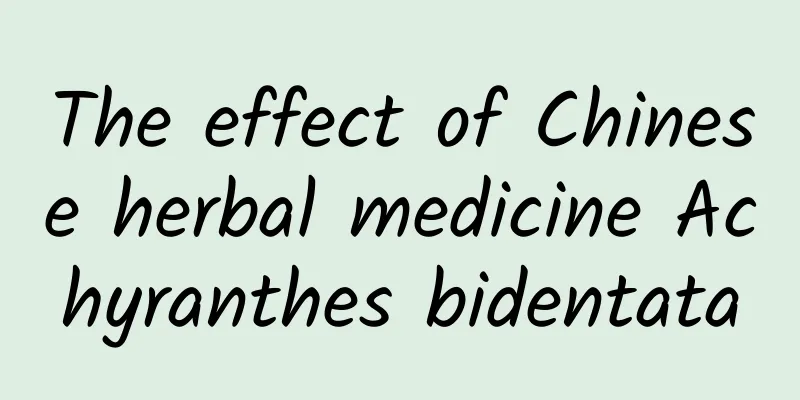The effect of Chinese herbal medicine Achyranthes bidentata

|
When it comes to Achyranthes bidentata, perhaps many people think of it as food, which is what many people call the cow's knee. So the Achyranthes bidentata mentioned here is not the cow's knee, etc., but a traditional Chinese medicine. Its name is Achyranthes bidentata. Of course, it has nothing to do with the cow's knee. The traditional Chinese medicine Achyranthes bidentata has many functions, and different functions bring different effects. In short, it still has certain benefits for the human body. The traditional Chinese medicine Achyranthes bidentata is not so familiar to many people, and even more people have never seen it. We must first understand all aspects of the Chinese medicine Achyranthes bidentata so that we can fully understand the effects of the Chinese medicine Achyranthes bidentata. Based on this, let’s introduce the effects of the traditional Chinese medicine Achyranthes bidentata in detail. Achyranthes bidentata was first recorded in Shennong's Herbal Classic and has been discussed in many herbal books throughout the ages. There are many kinds of Achyranthes bidentata, and those used as medicine include Sichuan Achyranthes bidentata, Huaihai Achyranthes bidentata, and Local Achyranthes bidentata. Sichuan Achyranthes bidentata is produced in Sichuan and other places; Huai Achyranthes bidentata is produced in Wen County, Wuzhi, Bo'ai, Qinyang and other places in Henan Province, formerly known as Huaiqing Prefecture, hence the name; there is also a wild one called Native Achyranthes bidentata. The three are of different varieties. Achyranthes bidentata was first recorded in Shennong's Herbal Classic and has been discussed in many herbal books throughout the ages. The Annotated Compendium of Materia Medica says: "The one from Cai Qing, a nearby province, is the largest and softest. Its stem has nodes. The one with purple nodes and large ones is male, and the one with green and thin ones is female. The male one is the best." The Records of Traditional Chinese Medicine of Sichuan says: Sichuan Achyranthes "removes wind and dampness, dredges the menstruation and disperses blood. It can treat cold and dampness, waist and leg bone pain, foot paralysis and muscle spasm, amenorrhea and masses in women, gonorrhea, hematuria, impotence, and incontinence." The Records of Famous Doctors says: Huai Achyranthes "treats the lack of energy in the middle of the wound, the loss of male kidney yin, incontinence in the elderly, replenishes the middle and continues the dead, fills the bone marrow, removes brain pain and waist pain, women's menstrual blockage, blood clots, benefits essence, benefits yin qi, and stops graying of hair." The Supplement to Compendium of Materia Medica says: Tu Achyranthes "activates blood circulation and removes blood stasis, relaxes tendons, and treats injuries from falls. It can treat tetanus and seventy-two kinds of malignant diseases, and its merits are better than those of Sichuan products. It is also good at treating sores and piercing the flesh with arrows." The differences between the three types of Achyranthes bidentata are: Sichuan Cyathula - the root of the Amaranthaceae plant Sichuan Cyathula or Cyathula capitata, can dispel wind and dampness, dredge meridians and activate blood circulation, and is mainly used to treat rheumatic pain, foot weakness and muscle spasm, hematuria, hematuria, amenorrhea in women, and abdominal masses. Chinese rhubarb - the root of the Achyranthes bidentata plant of the Amaranthaceae family. When used raw, it can disperse blood stasis and eliminate carbuncles. It is mainly used to treat gonorrhea, hematuria, abdominal masses, dystocia, retained placenta, abdominal pain due to postpartum blood stasis, throat congestion, carbuncles, and injuries from falls. Cooked in water, it nourishes the liver and kidneys, strengthens the tendons and bones; it is mainly used to treat pain in the waist and knees, cramps in the limbs, paralysis, etc. Wild Achyranthes bidentata - the root of wild Achyranthes bidentata, willow leaf Achyranthes bidentata, etc. of the Amaranthaceae family. It can promote blood circulation, relieve blood stasis, remove dampness and promote urination, clear away heat and detoxify. It is mainly used to treat gonorrhea, hematuria, amenorrhea in women, abdominal masses, rheumatic joint pain, athlete's foot, edema, dysentery, malaria, diphtheria, carbuncle, traumatic injuries, etc. The comparison of medicinal properties is: Sichuan Achyranthes bidentata is biased towards removing blood stasis; Huai Achyranthes bidentata is biased towards nourishing the liver; and Thunbula Achyranthes bidentata is biased towards detoxification. Caution should be exercised during clinical use: patients with spleen deficiency, diarrhea, nocturnal emission, spermatorrhea, menorrhagia and pregnant women should not take the product. Through the detailed introduction in the above article, we can intuitively discover the effects of the traditional Chinese medicine Achyranthes bidentata. In fact, there are quite a lot of types of traditional Chinese medicine Achyranthes bidentata, and there is actually not much difference in the efficacy and effects of these different Achyranthes bidentata. The biggest difference is the appearance. In fact, knowing the effects of the traditional Chinese medicine Achyranthes bidentata will be beneficial to our future lives. Those who don’t believe it can wait and see. |
<<: The efficacy and function of traditional Chinese medicine placenta
>>: Side effects of Fufang Wangbuliuxing tablets
Recommend
What is the cause of pain in the instep meridians?
There are many reasons for meridian pain in the d...
Does taking folic acid cause nausea?
It is also a nutrient necessary for the growth an...
What are the causes of stinging around the nose when applying a facial mask?
Women love beauty very much. In order to make the...
Symptoms of alkali poisoning
Alkali poisoning is mainly caused by too high con...
Why is pregnancy reaction so strong?
The changes that women experience after pregnancy...
Why do new smokers feel dizzy?
There are relatively large numbers of people smok...
Does dental fillings have any impact during breastfeeding?
A woman's physical health condition can be mo...
What are the dangers of autologous fat breast augmentation?
In fact, many people don’t know that common breas...
What is the normal heart rate during deep sleep?
We all know that the normal beating of the human ...
What causes pain in the middle of the chest?
From a clinical perspective, pain in the middle o...
What to do if your hair turns grey at 40
After people reach the age of 40, the melanin pro...
What is the cause of white discharge in the eye?
When there is white secretion in the eyes, you mu...
What to do if your teeth are too dirty
The so-called dirty teeth mainly refer to dental ...
What are the common symptoms of early nephritis?
According to incomplete statistics, kidney diseas...
Will taking isotretinoin capsules improve skin quality?
Isotretinoin skin capsules are suitable for more ...









